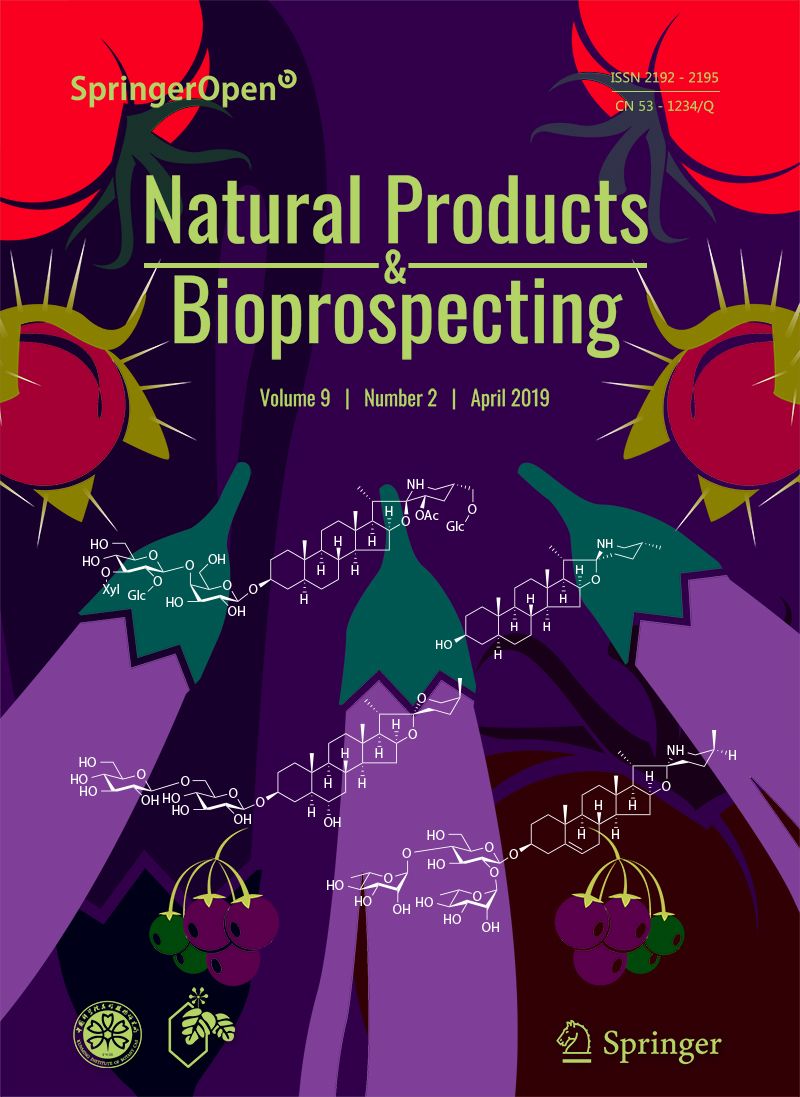|
|
The Genus Solanum: An Ethnopharmacological, Phytochemical and Biological Properties Review
Collect
Joseph Sakah Kaunda, Ying-Jun Zhang
Natural Products and Bioprospecting. 2019, 9 (2): 77-137.
DOI: 10.1007/s13659-019-0201-6
Over the past 30 years,the genus Solanum has received considerable attention in chemical and biological studies.Solanum is the largest genus in the family Solanaceae,comprising of about 2000 species distributed in the subtropical and tropical regions of Africa,Australia,and parts of Asia,e.g.,China,India and Japan.Many of them are economically significant species.Previous phytochemical investigations on Solanum species led to the identification of steroidal saponins,steroidal alkaloids,terpenes,flavonoids,lignans,sterols,phenolic comopunds,coumarins,amongst other compounds.Many species belonging to this genus present huge range of pharmacological activities such as cytotoxicity to different tumors as breast cancer (4T1 and EMT),colorectal cancer (HCT116,HT29,and SW480),and prostate cancer (DU145) cell lines.The biological activities have been attributed to a number of steroidal saponins,steroidal alkaloids and phenols.This review features 65 phytochemically studied species of Solanum between 1990 and 2018,fetched from SciFinder,Pubmed,ScienceDirect,Wikipedia and Baidu,using "Solanum" and the species'names as search terms ("all fields").
References |
Related Articles |
Metrics
|
|
|
Anti-oral Microbial Flavanes from Broussonetia papyrifera Under the Guidance of Bioassay
Collect
Chang-An Geng, Meng-Hong Yan, Xue-Mei Zhang, Ji-Jun Chen
Natural Products and Bioprospecting. 2019, 9 (2): 139-144.
DOI: 10.1007/s13659-019-0197-y
A new flavane,bropapyriferol (1),and eleven known ones were isolated from the EtOAc part of Broussonetia papyrifera under the guidance of bioassay.The structure of compound 1 was determined by extensive 1D and 2D NMR,[α]D spectroscopic data and quantum computation.Daphnegiravan F (2) and 5,7,3',4'-tetrahydroxy-3-methoxy-8,5'-diprenylflavone (3) showed significantly anti-oral microbial activity against five Gram-positive strains and three Gram-negative strains in vitro.Especially,compound 3 was more potent in suppressing Actinomyces naeslundii and Porphyromonas gingivalis(MIC=1.95 ppm) than the positive control,triclosan.
References |
Related Articles |
Metrics
|
|
|
Two New Eudesmane Sesquiterpenoids from the Flowers of Chrysanthemum indicum
Collect
Jun-Li Yang, Lei-Lei Liu, Yan-Ping Shi
Natural Products and Bioprospecting. 2019, 9 (2): 145-148.
DOI: 10.1007/s13659-019-0199-9
The flowers of Chrysanthemum indicum,i.e.Ye-ju-hua recorded in the Chinese Pharmacopoeia,has been widely used in China as an important heat-clearing and detoxifying herb for the treatment of inflammation,headache,and vertigo.A phytochemical investigation of this herb has led to the isolation of two new eudesmane sesquiterpenoids,7-epi-eudesm-4(15),11(13)-diene-1β,3β-diol (1) and 7-epi-1β-hydroxy-β-eudesmol (2).The molecular structures of these new sesquiterpenoids were established based on the comprehensive spectroscopic analyses,including NMR,MS,and IR,and comparing with the literatures.
References |
Related Articles |
Metrics
|
|
|
Aristolane-type Sesquiterpenoids from Nardostachys chinensis and Revised Structure of Aristolanhydride
Collect
Li-Xia Wang, Xian-Jun Jiang, Xiang-Mei Li, Mei-Fen Mao, Guo-Zhu Wei, Fei Wang
Natural Products and Bioprospecting. 2019, 9 (2): 149-155.
DOI: 10.1007/s13659-019-0200-7
Four hitherto unknown aristolane-type sesquiterpenes,including one novel 8,9-secoaristolane,namely secoaristolenedioic acid (1),two aristolone derivatives,namely 1α,2β-dihydroxyaristolone (2),9-epidebilon (3),and one rare aristolane-chalcone hybrid,namely 3'-hydroxynardoaristolone A (4) were isolated from the ethanol extract of the roots and rhizomes of Nardostachys chinensis.Their structures were elucidated on the basis of extensive spectroscopic analysis.In addition,the structure of aristolanhydride,recently isolated from the same species,was corrected by reanalysis of the published NMR data.
References |
Related Articles |
Metrics
|
|
|
Bioactivity-Guided Isolation of Totarane-Derived Diterpenes from Podocarpus neriifolius and Structure Revision of 3-Deoxy-2α-hydroxynagilactone E
Collect
P. Annécie Benatrehina, Wei-Lun Chen, Austin A. Czarnecki, Steven Kurina, Hee-Byung Chai, Daniel D. Lantvit, Tran N. Ninh, Xiaoli Zhang, Djaja D. Soejarto, Joanna E. Burdette, A. Douglas Kinghorn, L. Harinantenaina Rakotondraibe
Natural Products and Bioprospecting. 2019, 9 (2): 157-163.
DOI: 10.1007/s13659-019-0198-x
Bioactivity-guided phytochemical investigation of Podocarpus neriifolius D.Don.(Podocarpaceae) has led to the isolation of one new (2) and three known (1,3,and 4) B-type podolactones,along with three totarane-type diterpenes (5-7).Their structures were determined by interpretation of High Resolution ElectroSpray Ionization Mass Spectrometry (HRESIMS) and 1D and 2D NMR data,and comparison with the values reported in the literature.The structure of compound 1,previously identified as 3-deoxy-2a-hydroxynagilactone E (8),was revised as its 2β-epimer,which has been reported recently as a new compound.All of the isolates were evaluated for their antiproliferative activity against a panel of four human cancer cell lines,namely,ovarian (OVCAR3),breast (MDA-MB-231),colon (HT-29),and melanoma (MDA-MB-435),and compounds 1 and 3 were found to be cytotoxic with IC50 values in the low micromolar range for most of the cell lines used.The major compound,inumakilactone A (3),was further tested in vivo using the HT-29,MDA-MB-435,and OVCAR3 cells in a murine hollow fiber model,for the first time.
References |
Related Articles |
Metrics
|
|

